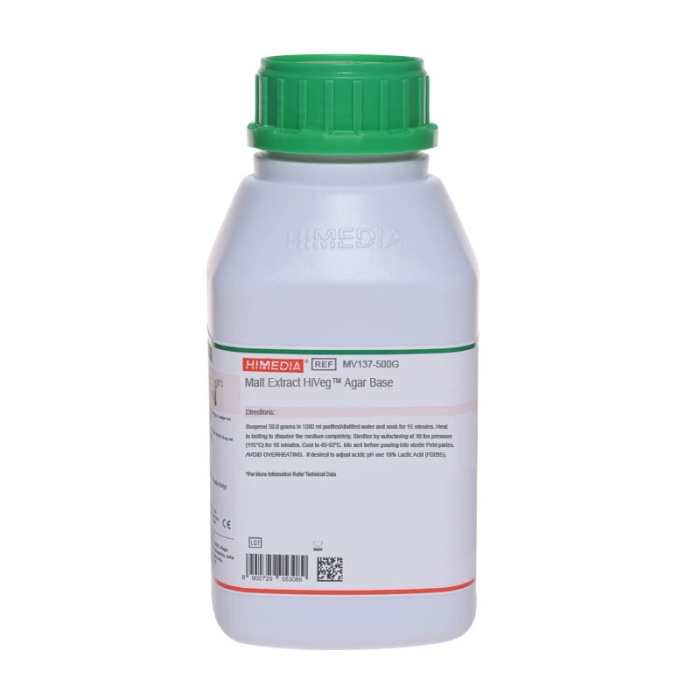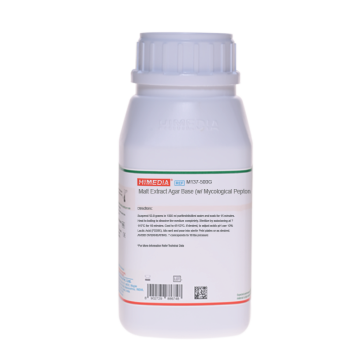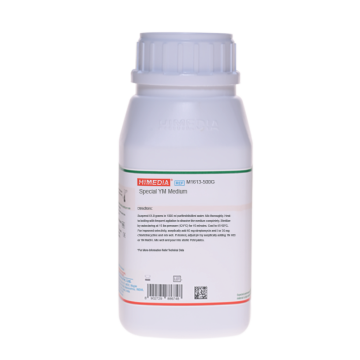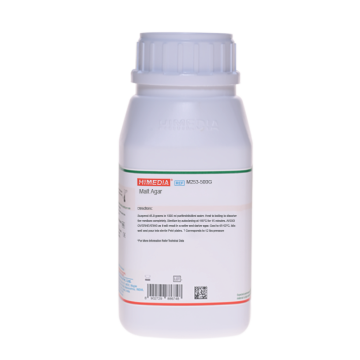 Your enquiry has been submitted
Your enquiry has been submitted
Preservative Resistant Yeast Agar Base (PRY)
Intended Use
Recommended for cultivation of yeasts.
Composition
| Ingredients | Gms / Litre |
|---|---|
| Yeast extract | 10.000 |
| Mannitol | 10.000 |
| Agar | 15.000 |
**Formula adjusted, standardized to suit performance parameters
Directions
Suspend 35 grams in 1000 ml purified / distilled water. Heat to boiling to dissolve the medium completely. Sterilize by autoclaving at 15 lbs pressure (121°C) for 15 minutes. Cool to 45-50°C and add 10 ml glacial acetic acid and immediately dispense as desired, because the medium cannot be reheated.
Principle And Interpretation
Preservative Resistant Yeast Medium is used to selectively isolate and enumerate Zygosaccharomyces species. It is used for the detection of preservative resistant yeast in water and beverages. The medium prevents growth of other yeasts such as Saccharomyces cerevisiae that are tolerant to lower levels of commonly used food preservatives. Spoilage resulting from growth of the yeast Zygosaccharomyces is widespread, which has caused significant economic losses to the food industry. Within this genus, Z. bailii is one of the most troublesome species due to its exceptional tolerance to various stressful conditions (4). Also Z. lentus is a significant new osmophilic, preservative-resistant spoilage yeast, capable of growth at low temperature (7).
Yeast extract in the medium provides the essential nutrients, while mannitol acts as source of fermentable carbohydrate.
Type of specimen
Food; Water samples.
Specimen Collection and Handling
For food and dairy samples, follow appropriate techniques for sample collection and processing as per guidelines (1,6,8).
For water samples, follow appropriate techniques for sample collection, processing as per guidelines and local standards(2).
After use, contaminated materials must be sterilized by autoclaving before discarding.
Warning and Precautions
Read the label before opening the container. Wear protective gloves/protective clothing/eye protection/ face protection. Follow good microbiological lab practices while handling specimens and culture. Standard precautions as per established guidelines should be followed while handling specimens. Safety guidelines may be referred in individual safety data sheets.
Limitations
- Some species may show poor growth due to nutritional variations.
Performance and Evaluation
Performance of the medium is expected when used as per the direction on the label within the expiry period when stored at recommended temperature.
Quality Control
Appearance: Cream to yellow homogeneous free flowing powder
Gelling: Firm, comparable with 1.5% Agar gel
Colour and clarity of prepared medium: Light amber coloured clear to slightly opalescent gel forms in Petri plates
Cultural Response: Cultural Response was observed at 20-25°C for 2-7 days. Recovery rate is considered as 100% for fungus growth on Sabouraud Dextrose Agar
| Organism | Growth |
|---|---|
| Candida albicans ATCC 10231 (00054*) | luxuriant |
| Zygosaccharomyces bailii | luxuriant |
| Saccharomyces cerevisiae ATCC 9763 (00058*) | good |
Key : (*) Corresponding WDCM numbers.
Storage and Shelf Life
Store between 10-30°C in a tightly closed container and the prepared medium at 20-30°C. Use before expiry date on the label. On opening, product should be properly stored dry, after tightly capping the bottle in order to prevent lump formation due to the hygroscopic nature of the product. Improper storage of the product may lead to lump formation. Store in dry ventilated area protected from extremes of temperature and sources of ignition. Seal the container tightly after use. Product performance is best if used within stated expiry period.
Disposal
User must ensure safe disposal by autoclaving and/or incineration of used or unusable preparations of this product. Follow established laboratory procedures in disposing of infectious materials and material that comes into contact with clinical sample must be decontaminated and disposed of in accordance with current laboratory techniques (3,5).
Reference
- American Public Health Association, Standard Methods for the Examination of Dairy Products, 1978, 14th Ed., Washington D.C.
- Baird R.B., Eaton A.D., and Rice E.W., (Eds.), 2015, Standard Methods for the Examination of Water and Wastewater, 23rd ed., APHA, Washington, D.C.
- Isenberg, H.D. Clinical Microbiology Procedures Handbook 2nd Edition.
- James, S.A., Stratford, M., 2003. Spoilage yeasts with emphasis on the genus Zygosaccharomyces. In: Boekhout, T. and Robert, V. (Eds), Yeasts in food - Beneficial and detrimental aspects. Woodhead Publishing Ltd and CRC Press, Cambridge,pp. 171-191.
- Jorgensen, J.H., Pfaller, M.A., Carroll, K.C., Funke, G., Landry, M.L., Richter, S.S and Warnock., D.W. (2015) Manual of Clinical Microbiology, 11th Edition. Vol. 1.
- Salfinger Y., and Tortorello M.L. Fifth (Ed.), 2015, Compendium of Methods for the Microbiological Examination of Foods, 5th Ed., American Public Health Association, Washington, D.C.
- Steels, H., James, S. A., Roberts, I. N. and Stratford, M. (1999). Journal of Applied Microbiology, 87: 520–527. doi: 10.1046/j.1365-2672.1999.00844.
- Wehr H. M. and Frank J. H., 2004, Standard Methods for the Microbiological Examination of Dairy Products, 17th Ed., APHA Inc., Washington, D.C.
| Product Name | Preservative Resistant Yeast Agar Base (PRY) |
|---|---|
| SKU | M1914 |
| Product Type | Regular |
| Physical Form | Powder |
| Origin | Animal Free (Microbial) |
| Packaging type | HDPE |
| References | 1.James, S.A., Stratford, M., 200 |
| Customized Product Available | No |













